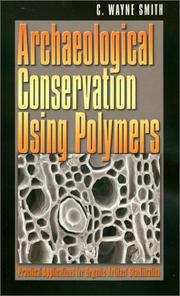Check nearby libraries
Buy this book

"Over the years, archaeologists have developed a number of techniques for conserving historical artifacts for future generations. Along with these techniques, researchers have developed a series of ethical principles for treating materials in a way that allows them to be not only observed and analyzed for the present, but also re-studied in the future.
Conservation techniques used up to now, however, have provided artifacts only a limited lifespan, and in some cases they do not work well with waterlogged materials. Within the past few years, archaeological chemistry and concerns of longevity testing have become central issues in the development of conservation treatment strategies.".
"Working with Dow Corning Corporation, Texas A&M's Archaeological Preservation Research Lab (APRL), and the Conservation Research Lab (CRL), Smith and his colleagues in AS&M's Nautical Archaeology Program set out to develop a series of chemistries and techniques that would provide successful and affordable treatment strategies for organic materials.
In this ground-breaking description of the processes and materials that were developed, Smith explains these techniques in ways that will allow museums and historical societies to conserve more stable artifacts for traveling exhibits and interactive displays and will allow researchers to conserve new discoveries without sacrificing important information.".
"Beyond the advantages offered by polymer replacement (Passivation Polymer) technologies, Smith considers a concept seldom addressed in conservation: artistry. Variance in equipment, relative humidity, laboratory layout, intended results, and level of expertise all affect researchers' ability to obtain consistent and aesthetically correct samples and require a willingness to explore treatment parameters and combinations of polymers.".
"Smith prescribes an effective layout for day-to-day conservation of small organic artifacts and then examines some of the mechanical techniques used to process various organic materials from marine and land sites. He concludes with an exploration of new tools and technologies that can help conservators devise more effective conservation strategies, including CT scans and Computer Aided Design images and stereolithography.".
"All archaeologists, conservators, and museologists working with perishable artifacts will benefit from the careful explication of these new processes, and those wishing to incorporate some or all of them will find the step-by-step instructions for doing so."--BOOK JACKET.
Check nearby libraries
Buy this book

Previews available in: English
Showing 1 featured edition. View all 1 editions?
| Edition | Availability |
|---|---|
|
1
Archaeological conservation using polymers: practical applications for organic artifact stabilization
2003, Texas A&M University Press
in English
- 1st ed.
1585442178 9781585442171
|
aaaa
Libraries near you:
WorldCat
|
Book Details
Edition Notes
Includes index.
Classifications
External Links
The Physical Object
ID Numbers
Community Reviews (0)
Feedback?History
- Created April 1, 2008
- 16 revisions
Wikipedia citation
×CloseCopy and paste this code into your Wikipedia page. Need help?
| November 15, 2023 | Edited by MARC Bot | import existing book |
| December 7, 2022 | Edited by ImportBot | import existing book |
| February 25, 2022 | Edited by ImportBot | import existing book |
| September 29, 2021 | Edited by ImportBot | import existing book |
| April 1, 2008 | Created by an anonymous user | Imported from Scriblio MARC record. |









